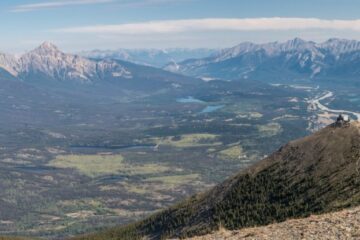When you’re planning a rail journey with lots of changes, it pays to think like a triathlete and visualise smooth transitions.
Watching the Olympic triathlon this summer I remember why they call transition the fourth discipline. It’s where valuable minutes can be saved.
In the 1980s I went on a press jolly to the Nice Ironman triathlon. In those early days, before the all-in-one tri-suit was a Thing, competitors emerged from the Mediterranean and pulled off their trunks and cossies (yes, completely) to change into cycling kit. That’s a sight I can’t easily unsee.
Now, transition – moving from swim to bike, from bike to run – is all over in a flash, but without the flashing. And it needs training every bit as thorough as the three athletic disciplines. The other day my friend Pam and I saw a man running barefoot from his van to his bike, cycling a couple of hundred metres, changing his shoes and running back to his van. Pam couldn’t make sense of it, but it was clear to me – he was transition training.
GB age-related triathlete David Cooper, who’s preparing for the World age-related sprint championships in Bermuda in October, practises transition in his garden. He writes down a strict to-do list from bottom to top. He visualises every step. Most important, he leaves his prescription swimming goggles on until he reaches his bike, “otherwise all bikes look the same!”
Across the tracks
Managing the transitions between railway trains can also save valuable minutes. Last month I travelled from Penrith to Worcester to attend the Sport Parkinson’s Try-athon. It was a wonderful opportunity to meet other sporty PwPs and try lots of new activities. Two years ago, when I was in ‘frightened rabbit’ mode’, I wouldn’t have been able to plan and execute this journey on my own. But I didn’t do my homework first, so there were still some anxious moments.
Research your transition stations
I learned some lessons from this trip, not least of which is that Smethwick Galton Bridge station is the work of the Devil. Or if not the Devil, then MC Escher, he of the illusional staircases. I’d assumed this little station would be two platforms – one up and one down, where I could just wait on the same platform. But two lines intersect at right angles to each other, on two different levels. That’s a lot of steps up.
I reached platform 2 and could see people waiting on the other side for my train due in a few minutes. But I couldn’t see how to get there – more stairs to the footbridge were neatly concealed. “How do I get to platform 1?” I barked as I ran along, rather like Anneka Rice in Treasure Hunt, but with a bigger bottom. I only caught the train because a nice young man stuck his foot in the door. So the questions to ask in advance include:
- Do you have to change platforms?
- Which carriage is nearest the lift (if it’s working)?
- Which carriage is nearest the stairs (if it’s not)?
- How long do you have between trains (if they are on time)?
National Rail publishes maps showing the layout of every station, although I notice they haven’t updated it to include the lift at Penrith. Ours was the last mainline station to get a passenger lift, opened in December 2016. Until then people who couldn’t use the stairs from Platform 2 to the exit either had to stay on the train to Carlisle and then turn around and come back again; or they (even a peer of the realm) had to be bundled hurriedly across the tracks by station staff between trains. Very undignified.
Here is the map for Preston station.

Look at alternatives
- Do your first and second journeys have stations in common before their tracks diverge?
- What is their platform layout like?
- If you stayed on your first train, would you still catch your second train further down?
- If transition means getting off one train and staying where you are till your connecting train arrives, why worry about changing platforms at Preston when you can sit tight till Crewe?
- Can you skip your rogue station altogether? I came back via Birmingham New Street, and the grubby station I remember from uni days is absolutely spotless, with new toilets, plenty of room for social distancing, and clear departure boards and signposting. And an M&S food hall.
Track your train
- Check the service is still running the day before you travel. The operators are still trying to get back to some kind of normal.
- Have your phone charged.
- Using Train Line’s live Journey Tracker, start following your train’s progress.
- Start doing the sums the minute you realise your train is late.
- If you want belt, braces and baler twine, print off paper copies of the timetable before you leave.
- If the ticket person comes around, ask them.
Ready, set, go!
“Ladies and gentlemen, we are now approaching Preston” is way too late to get up and get your luggage together. Everyone else will be doing the same thing. Very slowly.
“We welcome passengers joining us at Lancaster” is a much more timely prompt to start packing up and heading for the door. You need to be the one in pole position pressing the green button. On the correct side for the platform.
Tube maps
If a journey includes the London Underground, the homework is easier. TfL’s Journey Planner gives approximate transfer times:

And an app called Tube Maps (Apple, Android) tells me which carriage to be in for the exits. It also has clear accessibility information for each station.

Managing long waits
What if it all goes t*ts up and you do miss your connection? You may know Beth Pipe better as The Cumbrian Rambler, outdoor writer and now a radio DJ. She wears many hats, some of which she has knitted herself. With her sensible hat on she is a business skills trainer for the legal profession. Pre-COVID, this involved a lot of travel from her home in Grange-over-Sands all over the country. And a lot of hanging round on station platforms.

Beth made good use of her time in lockdown to build her online training skills and and now delivers most of her training from home. Her ‘commute’ is a daily stroll along Grange Promenade. There are fewer nightmare journeys and more time to amble and ramble.
Here are some of Beth’s words of wisdom for train travel:
- If it’s Northern Rail, always take one train earlier than you need to make a connection
- If you’re connecting through Leeds, take a satnav and allow half a day – it makes Smethwick Galton Bridge look like a walk in the park.
- If you have ages before your connection, walk the length of a few platforms to boost your step count and check out the architecture.
- Never EVER, travel without a flask, food, an extra layer, and something to keep you occupied that doesn’t require a battery. Treat it like a hike – expect to be stranded somewhere because it will happen. A good book* and a flask of tea always help.
- Go to the loo before you get off the train, especially if you’re travelling late in the evening – platform loos often close early at smaller stations. (9pm at Lancaster!)
*Maybe even Gin, Cakes and Rucksacks, Beth’s journey of discovery, with Karen Guttridge, around Lakeland distilleries.
The thrill of the chase
Although it adds some anxiety to the journey, I still rather enjoy the frisson of doing the sums and getting it right. If/when I ever consider myself disabled, I will take full advantage of Passenger Assist and have someone do the thinking for me. But where’s the fun in that?
Play > Last train to San Fernando > Johnny Duncan and the Bluegrass Boys
When you’re a little girl of six, there is a certain thrill to being able to sing the word ‘bum’ at the top of your voice without being told off.
“If you miss this one, you’ll never get another one
Biddy diddy bum bum to San Fernando”
Photo of Preston station by Creative Commons Attribution-Share Alike 2.5



3 Comments
Rosie · 20 August 2021 at 8:42 am
Now think about trying to do those journeys in a wheelchair, when not all stations have ramps, or the disabled assistance you requested simply fails to show! At Birkdale the ramp was chained to a wall for station staff to unlock … except that sometimes there arent any staff. I gave up bothering cowardice i know but too much stress makes me ill.
Christine Lindop · 27 August 2021 at 11:07 pm
I remember reading somewhere that the Tube app was put together by a guy who doggedly rode all the trains and worked it all out. As ever, a really good read.
Rob Cook · 3 September 2021 at 2:45 pm
I really enjoyed this, Ali. I am sooo in tune with what you say. When preparing for a gig, I’m always one of the people who wants our ORDERED set list well in advance. “Do you want to practice the silences?!” our band leader mocks. my answer, pretty much, is “Yes!”. Now I know it’s the transitions I’m practicing! By the way, Shipley is an interesting station to try and work out how to get to a platform! Rob